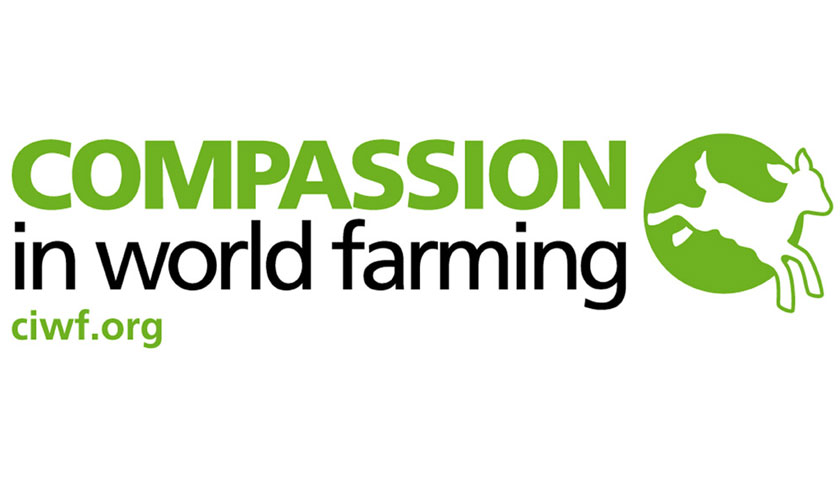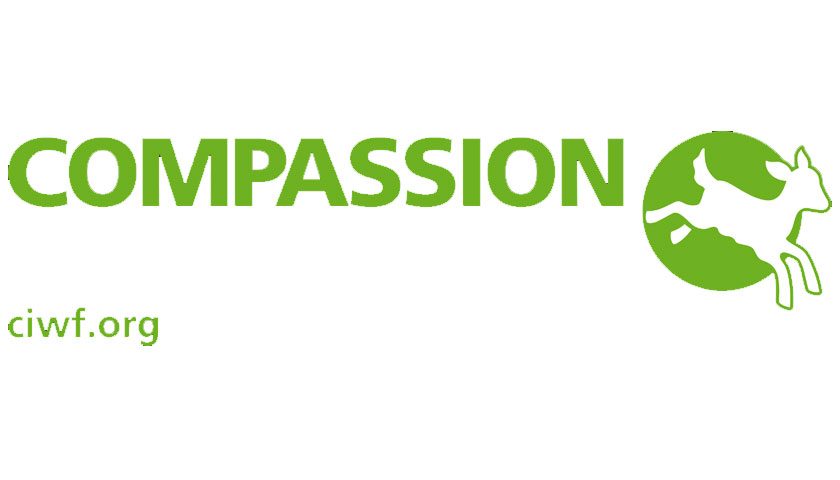Compassion in World Farming is expanding its work with the food industry to improve the welfare of farmed fish during rearing and slaughter. At a time when the world is facing a crisis of overfishing and with the consumption of fish on the rise, an expansion of fish farming has taken place, which is both unsustainable and, in many areas, inhumane in the way fish are treated.
Compassion is focussing its fish work on improving the welfare of five of the most popular farmed species, including Atlantic Salmon, European Sea Bass, Gilthead Sea Bream and Rainbow Trout. Each species has different requirements for rearing and slaughter and Compassion has developed guides that look at each, with evidence -based recommendations to help companies develop their fish welfare policy frameworks. There are commonalities that need to be addressed across all species, not least the recognition of fish sentience.
Thanks to programmes like Sir David Attenborough’s Blue Planet, there is wide acceptance that fish lead complex lives and can feel pain, stress and fear, as well as exhibit positive emotions, social bonds and advanced intelligence. It is therefore essential that farmed fish are provided with the right environment to avoid stressful events (which can also impact on product quality) and to ensure they have a good quality of life.
Just as with land animals a holistic approach to fish welfare must be adopted. This approach is not simply related to fish health but must address their physical and mental wellbeing, as well as giving them the right environment to enable them to express appropriate behaviours. It must include humane slaughter practices so that animals don’t suffer and ‘are rendered unconscious until death prevails’. When inhumane methods are used (for example, submersion in a mixture of ice and water; suffocation in air; exposure to carbon dioxide; and bleeding without pre-stunning), fish are subject to pain and suffering which can last for several hours. Pre-slaughter procedures such as fasting, crowding and transport are also significant sources of stress and must be well managed to minimise suffering at the end of life.
The ’Attenborough effect’ was compounded in a survey of over 9,000 citizens from nine European countries in 2018, run by ComRes in partnership with Eurogroup for Animals. The survey found that 65% of the people questioned think that fish are sentient beings; 65% think that fish feel negative emotions such as fear and 55% think fish feel positive emotions such as pleasure. The majority of respondents also reported that they would be willing to pay more for higher welfare products with 79% stating they would like information about fish welfare to be visible on the packaging of all fish products, to enable them to make more informed choices about the wellbeing of the fish they buy and consume.
Just as consumer demand has helped to drive change for land animals, with the change in attitude towards cage-free eggs and a growing demand for improved broiler chicken welfare, the fish farming industry cannot afford to ignore the growing concerns expressed about fish welfare and the associated knock-on effect it is having on sustainability and the environment. Now is the time for companies to make improvements to their rearing and slaughter systems to future proof their businesses and the fish industry as a whole.
Compassion recommends that companies should build a framework for fish welfare which considers:
- Good Feeding – It is important that the right method of feeding is used to avoid unnecessary competition between fish (to avoid stress) and to ensure all fish get the right amount of food. In terms of sustainability, carnivorous fish are commonly fed with fishmeal and fish oil (FMFO) that relies heavily on wild caught fish. This needs to be reduced and requires a movement to more sustainable sources such as planted based feed (e.g. algal oils), potentially insects, and fish trimmings.
- Good Environment – Stocking density and water quality are key to a good environment and are interlinked. Stocking density in the fish cages should be set according to each breed, limiting overcrowding which causes injuries (such as de-scaling, snout and flank damage, fin erosion, cataracts and eye damage) and maximising space to enable fish to display appropriate behaviours. Good water quality is important for the fishes’ environment and dissolved oxygen, salinity, turbidity and temperature should all be monitored continuously, and measurements should be taken not only from surface waters but throughout the depth of the cage. This data is crucial to better understand fish behaviour and their wellbeing.
- Good Health – Farmed fish are more vulnerable to disease than their counterparts that live in the wild as intensive farms often create the ideal conditions for diseases to spread. Disease treatments for common illnesses such as sea lice can cause major welfare problems and ‘cleaner’ fish – sometimes introduced to the stock to feed on the lice – can also suffer from welfare issues themselves and should be phased out. All fish should be assessed for suitability prior to any disease treatment or management procedure and all treatments should be recorded in a veterinary health and welfare plan. The plan should outline planned husbandry procedures, risk assessments, disease monitoring and all treatments carried out, including the limited use of antibiotics and vaccinations.
- Normal Behaviours – Enriched environments specific to each breed will give fish more opportunity to exhibit appropriate behaviours and further research is needed in this area to ensure fish have positive welfare experiences and a good quality of life. Care should be taken during crowding and handling as these are highly stressful times for the fish, when injuries and mortalities can occur. Crowding, handling and grading should therefore be avoided as much as possible but, when unavoidable, should be performed in such a way as to minimise stress. This will involve careful management and monitoring of procedures and responding appropriately to ensure fish welfare throughout.
- Humane Slaughter – Humane slaughter practices that render the fish unconscious until death prevails are important so that the fish don’t suffer. Humane methods of fish slaughter do exist and are being developed and adopted across the industry. For example, Tesco[2] has introduced a humane slaughter system for sea bass and sea bream where the fish are pumped onto the harvest vessel from their pens and electrically stunned and rendered unconscious which lasts to death, following immersion in ice-slurry. Reducing stress before slaughter is not only more humane but has product quality benefits too.
We are currently facing a global crisis of overfishing and witnessing an increasing number of ‘dead zones’ in our oceans caused by excessive pollution. Couple this with a rise in the consumption of fish as more people decrease their red meat consumption and turn to healthier diets which advocate eating oily fish, we are seeing an aggressive expansion of fish farming which is unsustainable.
The welfare of farmed fish is an increasing focus for food companies and there is already some progress being made in this area. However, the industry urgently needs to review and improve fish welfare practices during rearing and slaughter and continually monitor procedures to ensure their inputs are working, by introducing animal-based welfare measurement outcomes. Although more research needs to be done to identify a set of reliable positive welfare indicators which can be used to build production systems that promote positive experiences for farmed fish, Compassion’s Food Business team has developed detailed, freely available resources to help companies achieve this end.
Dr Tracey Jones, Director of Food Business at Compassion in World Farming concludes: “The scale of suffering is immense when you consider that up to 3 trillion fish are killed annually for human consumption and for fish meal and fish oil as feed. When you compare this number to 74 billion land animals, it gives you an idea of the magnitude of the change that is needed.
“It is inevitable that consumer demand will push for change in fish welfare as it has done for other land animals and businesses must start addressing the issues now, by shoring up their supplier policies to include humane slaughter practices and ensure good welfare for all farmed fish throughout life. Don’t think this action can wait – act now.”
For further information on how to work with Compassion’s Food Business team, visit https://www.compassioninfoodbusiness.com

